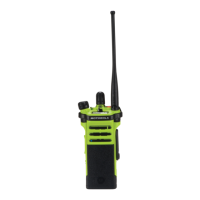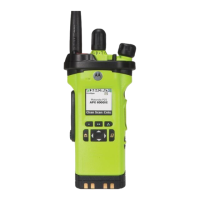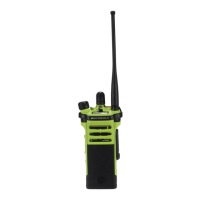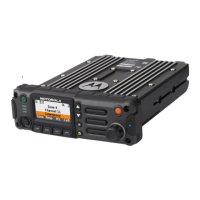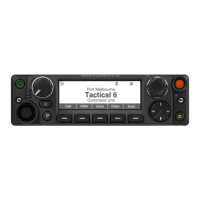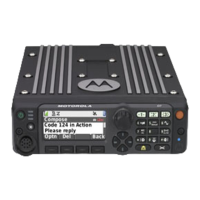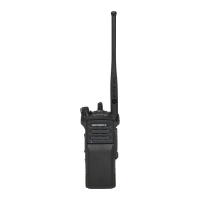3-16 Theory of Operation: Transceiver Board
3.1.3.7.3 Current Control Mode
In TDMA mode, excessive transient adjacent channel splatter caused by the RFPA, when it is under
a greater degree of compression than is expected at nominal supply voltage, is mitigated through a
system of saturation detection and switching of the TX power control mode from the voltage control
loop to the current control loop. Comparator U1131 compares the log amp output in voltage control
mode to a threshold voltage from DAC “C”, which sets the threshold for handover to current control
mode and establishes the upper supply rail for the output of current loop integrator, U1104. This
threshold is tuned in the factory to correspond to transmitter rated power which means that the
threshold for handover occurs at a level corresponding to rated power minus 6% (9% for VHF radios)
which is set by divider R1162 and R1163. When PA saturation exceeds this threshold and the MAKO
T/R control signal (DIG_GPIO49) and DIG_DMCS combine logically to signal the end of the data
portion of the TX slot, D-flip flop U1132 latches which in turn switches (via U1133 SPDT switch) the
output of the current loop integrator, U1104, as a control voltage to the PA of the radio.
Integrator, U1104, acts as a PI (Proportional Integral) controller in current mode. Current feedback
from the PA is obtained through current shunt resistor R1103 and sent to the current shunt monitor/
current to voltage converter, U1101. U1101 has a known gain characteristic for the current-to-voltage
conversion. The MAKO ramp is passed through a RC low pass filter for smoothing and on to the
current control integrator where it is proportioned with the voltage output of the current shunt monitor.
The integrator supply voltage comes from DAC “C” of the Quad DAC, U1125. By way of tuning the
DAC “C” value to match TX rated (tuned) power, this approach fixes the upper limit of the control
voltage in current control mode to correspond to the tuned power level, further reducing excess
adjacent channel splatter.
3.1.3.7.4 PA Offset, Control Voltage Gain Scaling
An offset voltage is applied to the control voltage at a summing junction made up of R1174 and
R1154 as a means of further improving transient adjacent channel splatter in the VHF band by
pre-biasing the PA. The output of DAC “A” is summed with either the output of the log amp or the
integrator through R1174.
The value for DAC “A” has been established and fixed in the firmware. This offset value is padded to
the control voltage and is sent to a non-inverting, gain-scaling amplifier, U901 (VHF) or U1601
(UHF1) or U1501 (UHF2) or U1001 (7/800 MHz) and then to the PA driver and final.
3.1.4 Frequency Generation Unit (FGU)
The frequency-generation function is performed by several ICs; multiple voltage-controlled
oscillators (VCOs); and associated circuitry. The reference oscillator provides a frequency standard
to the Trident IC, which controls the VCOs via the port expander. There are also buffers that amplify
the VCO signal to the correct level for the next stage. Figure 3-11 below shows a block diagram of
the FGU Section.
VHF: Two VCOs are employed: one to generate the first RX LO and the other to generate the
transmit injection signals.
UHF1: Two VCOs generate the first Rx LO and two VCOs generate the transmit-injection signals.
UHF2: Two VCOs generate the first Rx LO and two VCOs generate the transmit-injection signals.
700–800 MHz: Two VCOs generate the first RX LO and three VCOs generate the transmit-injection
signals.
NOTE: Refer to Table 8-1, “List of Transceiver Schematics and Board Overlays,” on page 8-1 for a
listing of FGU-related schematics that will aid in the following discussion.
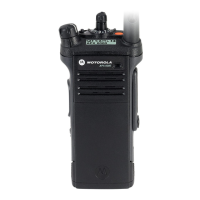
